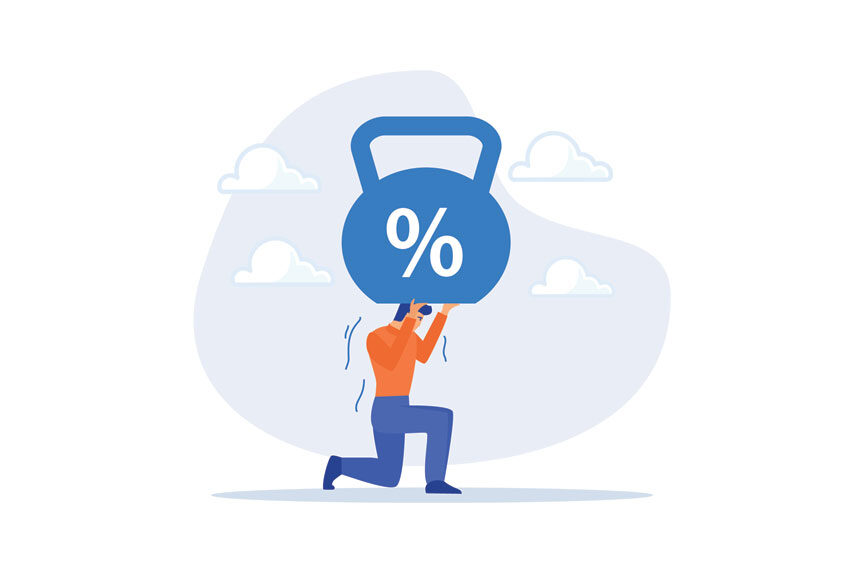In 2010, a South Dakota bank with the redundant name of First Premier Bank offered a credit card for consumers with bad credit. It gave successful applicants a credit limit of $300 and an interest rate of 29.9 percent. Six months later, customers found their interest rate automatically had shot up to 79.9 percent.
Not surprisingly, many dropped the card and looked for an alternative. To retain customers, First Premier lowered its rate to 59.9 percent. Proving how badly consumers labelled “credit risks” need cards, nearly 700,000 people signed up at this rate.
Today, the bank offers an interest rate of 36 percent, with a one-time processing fee of $95 in addition to annual fees, late fees, and other fees. In fairness to the bank, this card is intended for consumers who would be high credit risks.
Still….36 percent!
Most credit-card holders are accustomed to much lower rates: the average rate in 1980 was 17.3 percent and in 2008, 12 percent.
For many years, 36 percent interest was considered a national standard for usury, the crime of lending money with excessively high interest. But usury laws are set by state governments, and in the late 1970s a few states abandoned these restrictions. Which is how First Premier was able to charge 79.9 percent.
Not long after South Dakota dropped its usury limit, the Supreme Court essentially legalized usury for every state in Marquette National Bank of Minneapolis v. First of Omaha Service Corp.
Back then, state laws allowed Minnesota banks to charge up to 12 percent interest, but Nebraska banks could charge up to 18 percent, claiming each state could set its own interest rate. The Supreme Court agreed with that point, but ruled that a national bank — i.e., a commercial bank chartered by the federal government and a member of the Federal Reserve — could “export” its interest rate to other states.
In the wake of the Court’s ruling, a few states saw a golden opportunity. South Dakota’s usury-free climate enticed Citibank to move its credit card division to Sioux Falls, ultimately creating 3,000 new jobs in that area. Other banks followed Citibank’s example, moving their credit card operations to usury-free states like Delaware or Nevada.
Thirty-six percent may be today’s highest credit card interest rate, but it’s nowhere near the highest consumer interest rate. Payday loan companies, which advance cash on a borrower’s anticipated paycheck, have charged up to 780 percent annual prime rate.
At 400 percent, which is a more common rate, the lender would charge $15 per $100 for a two-week loan. A loan of $300 would require repayment of $345.
Since the 1980s, paycheck loan storefront businesses have grown from 500 to over 22,000, which makes them more numerous than Starbucks coffee shops and McDonald’s restaurants. The industry handles over $42.6 billion a year.
Some form of payday lending is now legal in 32 states. Most of these states limit how many times a borrower can renew their loan, and some limit how many loans a borrower can take in a year.
In Texas, interest can reach 662 percent. A $300 loan costs $370 if repaid in two weeks, but $1,001 if repaid in five months.
While very high, the interest can still be less than the late fees charged by some utilities and household creditors, or the overdraft fees charged by some banks.
But if the loan isn’t repaid in time, interest charges rise sharply, making repayment difficult. And the Consumer Financial Protection Bureau says 80 percent of payday loans don’t get paid back in two weeks.
Only 1 percent of all payday loans go to one-time borrowers who need money for an emergency.
Critics say these loans prey upon the young, the vulnerable, and the poor. They principally serve people earning between $15,000 and $25,000 — well below the poverty level for a family of four.
Behind any discussion about interest rates is the moral issue: is any interest justifiable? For much of human history, loaning money at interest was considered slightly-to-outright immoral. It was denounced in ancient Hindu and Buddhist texts. Beginning in the 4th century, the Christian church prohibited the faithful from offering loans with interest. St. Thomas Aquinas said “[t]o take usury for money lent is unjust in itself, because this is to sell what does not exist, and this evidently leads to inequality which is contrary to justice.”
Without the incentive of earning interest, Christians didn’t want to lend money. So borrowers went to the Jewish people to borrow money. Mosaic Law did not allow charging interest to fellow Jews, but permitted the practice for Gentiles. Christians’ resentment toward their lenders gave rise to the myth that Jews were obsessed with money (which led to hundreds of Jewish money lenders in Britain being executed in 1275).
In an essay for the Acton Institute, Nathan Mech acknowledges the religious objections to interest, but offers justifications, arguing that the earning potential of money means what is loaned today is worth more than the same amount repaid in the future. To loan money without interest is to lose part of the whole over time; the lender loses both access to the cash and its earning potential.
Also, loaning involves risk. Without interest to offset the potential losses, there would be few, if any, sources of capital to pay for a car, a house, or a college education.
Borrowing money is a central feature of American life and, like a business, should benefit both borrower and lender. The problem with excessive interest is that lenders can continue making a profit well into the future, at a perilous cost to the borrower.
Become a Saturday Evening Post member and enjoy unlimited access. Subscribe now



